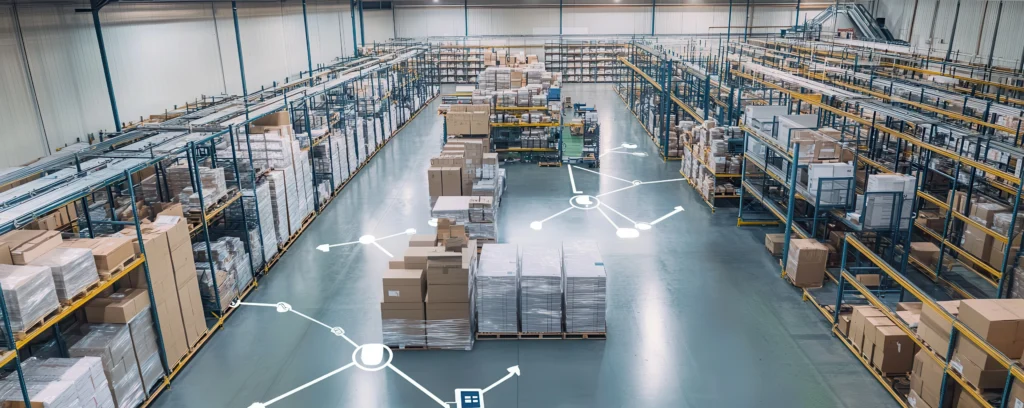Behind every fast delivery and accurate shipment is a warehouse management with coordination, strategy, and hard-earned efficiency. For businesses trying to keep up with today’s customer expectations, warehouse management is no longer just about moving boxes; it’s about building a system that runs smarter, not harder.
We’ve seen it firsthand: operations that once struggled with late shipments, misplaced inventory, and frustrated customers completely turn around after refining their warehouse processes. In this guide, we’re walking you through what that transformation looks like—and how to get there yourself.
So, What Is Warehouse Management Anyway?
At its core, warehouse management covers everything that happens inside your warehouse—from the moment goods arrive at the dock to the moment they leave in a delivery truck. That includes receiving, storing, tracking inventory, picking and packing orders, and shipping them out.
Sounds simple enough, right? But if you’ve ever tried juggling thousands of SKUs, fluctuating demand, and peak season rushes, you know there’s nothing simple about it. That’s where strategy, systems, and a bit of tech muscle come into play.
Breaking Down the Warehouse Management System (WMS)
Think of a Warehouse Management System (WMS) as the brain behind your warehouse. It’s the software that tells you what’s where, how much you have, and how to move it quickly and accurately.
What a Good WMS Should Do:
- Keep tabs on inventory in real time (no more guessing).
- Help workers pick the right items faster and with fewer errors.
- Suggest better storage locations for high turnover items.
- Automate tasks like restocking alerts and reorder points.
- Give you reports that mean something.
Whether you’re managing a small fulfillment center or a multi-location network, the right WMS can make your team more efficient and your customers a lot happier.
Receiving Inventory: Where It All Begins
Ever had inventory show up at your warehouse and then vanish into a black hole? It happens more often than people admit. Receiving is your first line of defense against inventory mistakes.
We recommend preparing for incoming shipments before the truck even back into the dock. Things like advanced shipping notices (ASNs) let your team plan, assign space, and reduce unloading chaos.
A Smarter Receiving Checklist:
- Use barcode scanning right at the dock.
- Document discrepancies immediately.
- Get items into the system as soon as they hit the floor.
- Prioritize fast-moving SKUs to get stored first.
A smooth receiving process sets the tone for everything that follows.
Storage Layouts That Work for You (Not Against You)
How you store your goods makes a bigger impact than you might think. Poor layouts can add hours of extra walking every day, create bottlenecks, and even lead to lost inventory.
We’ve helped clients rearrange their shelves and immediately saw faster picking rates. The key? Store what sells the most close to the packing stations.
Storage Tactics That Deliver:
- ABC Inventory Method: Put your fastest movers front and center
- Cross docking: Skip storage for high-demand items and ship out immediately
- Climate controlled zones: For sensitive goods like food or electronics
Small changes here often lead to big gains down the line.
Picking and Packing: Where Orders Come to Life
Let’s be real—this is where most mistakes happen. The wrong item, wrong quantity, or wrong address can all wreck a customer’s experience. But with the right systems, your team can pick faster and more accurately.

Real-World Fulfillment Strategies:
- Batch picking: Group similar orders to cut down on transit time
- Zone picking: Assign staff to specific areas to avoid confusion
- Pick-to-light or voice picking: Keep hands free and speed things up
- Pack stations with built-in scales and scanners: Catch errors before they ship
Getting this part right saves time, cuts down on returns, and earns customer loyalty.
Shipping: Don’t Let All That Work Go to Waste
After all the effort you’ve put in, the last thing you want is a delay at the shipping dock. Efficient outbound processes make sure everything leaves your warehouse quickly and correctly.
Our Outbound Must-Haves:
- Shipping software that compares carrier rates and delivery speeds.
- Smart packing that reduces waste and dimensional weight charges.
- Load planning to maximize truck space and minimize trips.
- Real-time tracking so customers (and your team) aren’t left guessing.
Shipping is where many companies drop the ball, don’t let that be your story.
Inventory Management: Always Know What’s in Stock
This one’s a deal-breaker. If your inventory is off, nothing else will run smoothly. Customers get backorders, your team wastes time searching, and you overspend on stock you don’t need.
We recommend routine cycle counts rather than waiting for full year-end audits. It’s less disruptive and much more effective at keeping numbers accurate.
Tips for Better Inventory Control:
- Use barcode or RFID tags for fast, accurate scanning.
- Set up automatic low-stock alerts.
- Track expiration dates for perishable items.
- Regularly review slow movers to avoid deadstock buildup.
Stay lean, stay informed, and stay flexible.
Making the Most of Your Warehouse Team
Your tech can only go so far without the right people using it. A well-trained, motivated warehouse team makes all the difference.
What We’ve Seen Work:
- Set daily and weekly performance goals.
- Use dashboards to keep everyone aligned.
- Cross-train employees to cover absences and reduce downtime.
- Offer bonuses for top performers to boost morale.
Technology supports the team but the team drives success.
Time to Talk Automation
Let’s face it: humans aren’t great at repetitive tasks. That’s where automation shines. Whether it’s conveyor belts, robotic picking arms, or automated guided vehicles (AGVs), the right tools can slash errors and speed up the workflow.
And you don’t need to go fully robotic overnight. Many companies start small—adding just a few automated systems—and scale from there.
Data and Analytics: Your Competitive Edge
Modern warehouses generate a goldmine of data. The real winners are those who use that data to make better decisions.
Track KPIs like
- Order accuracy
- Fulfillment speed
- Inventory turnover
- Labor productivity
Regular analysis highlights areas for improvement you might otherwise miss.
Sustainable Warehousing: Doing Good While Saving Money
Sustainability isn’t just a buzzword; it’s good business. From LED lighting to recyclable packaging and energy-efficient HVAC, the choices you make inside the warehouse matter.
Plus, customers and partners are paying more attention than ever.
Final Thoughts: Warehouse Management That Works
There’s no one-size-fits-all formula for warehouse success. But we’ve learned this: if you invest in smart systems, treat your team well, and continuously improve, the results speak for themselves.
At the end of the day, warehouse management isn’t just about logistics; it’s about keeping your promises. Every time a customer clicks “buy,” they’re counting on you. And when your warehouse runs right, you deliver.
Let’s make your warehouse the one customers and competitors talk about with TEU Global.



